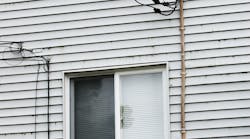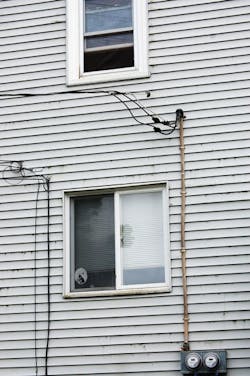How well do you know the Code? Think you can spot violations the original installer either ignored or couldn't identify? Here's your chance to moonlight as an electrical inspector and second-guess someone else's work from the safety of your living room or office. It's your turn to identify the violation.
Hint: A service that needs to be serviced
Find the Answer
Section 230.9(A) requires service conductors without an overall outer jacket to have a clearance of at least 3 ft from windows that are designed to be opened. The exception permits a clearance of less than 3 ft where the conductors are installed above the top level of the window. In this photo, the conductor’s clearance from the top of the bottom window is permitted. However, the clearance from the bottom of the top window is definitely problematic.
Section 230.26 similarly requires the point of attachment for the service drop conductors to comply with the same clearance requirements found in 230.9. Section 230.9(C) prohibits overhead service conductors from being installed beneath building openings where materials may be moved through. They cannot be installed where they obstruct the entrance to these building openings. With these service conductors being so close to the top window, a person could easily reach out the window and make contact with these energized conductors. This could create a real shock hazard.
In addition, these wires are so close to that window, a window-mounted air conditioner installed in that top window would practically touch the overhead service conductors.





